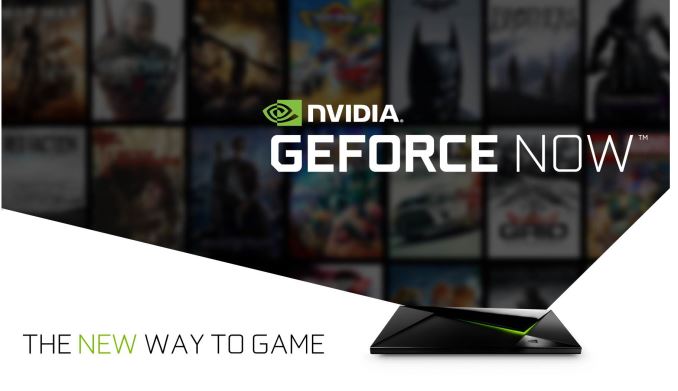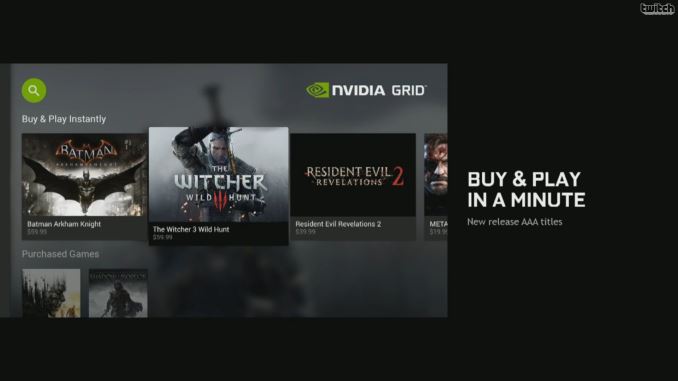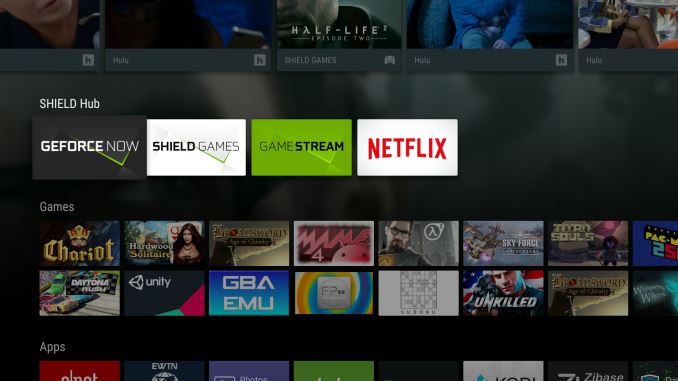NVIDIA's GeForce NOW - GRID Cloud Gaming Service Goes the Subscription Way
by Ganesh T S on September 30, 2015 9:00 AM EST- Posted in
- NVIDIA
- Shield
- Android TV
- Cloud Gaming

NVIDIA's GRID game streaming service was launched back in 2013 as a beta project. Over the last couple of years, they have added a number of features that bring together the capabilities of their data center GPUs and their Tegra SoCs. At GDC 2015, NVIDIA indicated that they would be promoting the GRID program from beta to a commercial service. The commercial service was originally slated to launch along with the SHIELD Android TV in May, but the launch kept getting pushed back.
Today, NVIDIA is announcing that the service is getting out of beta with a new tag - GeForce NOW. With widespread and reliable Internet connectivity, content consumption is going the streaming way - services such as Netflix, Spotify and Hulu boast a huge subscriber base. NVIDIA is hoping that GeForce NOW will become the de-facto service for consumers looking to stream games.
Game streaming is quite challenging compared to traditional media streaming - in addition to low latency real-time encoding on the server side, we also need the client user input to have minimal lag while getting reflected on the server side. Companies such as OnLive and Gaikai have tried to address this market with mixed success (getting bought out by Sony in 2015 and 2012 respectively).
However, from our limited time over the past two years with the GRID beta service, we have to say that the experience can be quite compelling - the gaming experience is instant without having to wait for multi-gigabyte downloads, and one has a huge library of games to choose from (similar to Netflix's library of movies). NVIDIA has been pushing hard to keep latency within reason - generally aiming for the equivalent of a console game at 30fps - and while network quality and location are paramount here, reasonably low latency is attainable if you live close enough to one of NVIDIA's hosting facilities.
Moving on, NVIDIA believes that the other major advantage for their streaming service is that the rendering GPUs are in the data center and can be regularly upgraded. The end-user side just needs a dumb decoder and gaming controller - the SHIELD Android TV is quite future proof here, as it can easily decode 4Kp60 streams and has a GbE LAN connector - so only the hosting side would need to catch up. Currently, the GeForce NOW experience provides for game streaming at up to 1080p60 at 25 Mbps, while a 720p30 stream at less than 10 Mbps is also available for users with limited bandwidth. Similar to Netflix, NVIDIA uses adaptive bit-rate streaming that can scale the quality appropriately within the available bandwidth.
The initial focus of GeForce NOW is on the SHIELD Tablet and SHIELD Android TV. NVIDIA also has long-term plans to enable PCs as clients for the service.
As for the structure of the service, back in March NVIDIA announced that this would be a multi-tier basic/premium service. However as things have been finalized, NVIDIA has reduced that to a single tier of paid service, and there has been no talk of a basic or free service ala the current free beta. As such the GeForce NOW service will be priced at $8/month, with a 3-month free trial period starting after sign-up.
In terms of games, the catalog has been fairly consistent in the type of games NVIDIA is offering over the lifetime of the GRID beta, and it appears that this will continue to be the case for the paid service. This would mean that the games on the subscription service will largely be second-run games that have already been on the market for 6 months or more; the previous Batman game, the next-to-latest GRID game, etc, with 50 or so games to kick things off. In this sense GeForce NOW is very similar to the early days of Netflix, with the service acting as a way of accessing second-run content for cheap.

GeForce NOW Buy & Play (From NVIDIA's March Service Announcement)
However NVIDIA is still bringing brand-new games to the service as well, and as previously announced back in March this will be through their Buy & Play program. Under Buy & Play, newer games that aren't available from the publisher for full subscription licensing can instead be purchased by individual customers for use with the streaming service, allowing customers to buy and immediately play these games on GeForce NOW. NVIDIA tells us that they will be rolling out new games under this program on a weekly basis, with the service launching with heavy hitters such as The Witcher III and Resident Evil: Revelations 2 available via Buy & Play on day one. However we should also note that based on NVIDIA's comments, it sounds like you must remain a subscriber in order to access the GeForce NOW service at all, so individual games picked up via Buy & Play would not be available if you discontinued your subscription.
Wrapping things up, NVIDIA has told us that GeForce NOW will be available in the US, Canada, Europe (incl. western Russia), Japan and South Korea starting today. The launch regions have been mainly dictated by the availability of data centers to serve the regions with minimal latency.
Finally, as part of the updates today, NVIDIA will also be more widely selling the SHIELD Android TV. In particular, Europe (UK, Germany, France and the Nordics) will finally be receiving the console, bringing the console beyond the American shores. Meanwhile in the US, we will start to see the STB available in brick and mortar stores such as Best Buy, Frys and Micro Center. And last but not least in a marketing promotion, Google Fiber outlets will also be promoting the SHIELD Android TV.











44 Comments
View All Comments
Morawka - Wednesday, September 30, 2015 - link
man your argument is just bad. People already use steam, GMG, Origin, Apple/Android Keychains and online shopping everyday. All of those services have waaay more identifiable information stored in the cloud than GRID would have.As long as they encrypt user data all the way down the stack, then information stolen cannot be accessed. The major hacks that have happened over the past 3 years have all been un-encrypted data, not even salted.
Society has learned it's lesson with the sony, and target hacks, and encryption is now becoming mainstream.
ddriver - Wednesday, September 30, 2015 - link
I don't think things are improving in this regard. I mean it doesn't take a genius to figure out that personal data should be protected. So then why it wasn't? Year after year we have data breaches, and I'd say if corporations were learning from this, they'd learn the first time.And how the industry is pushing even less secure authentication methods, such as fingerprints. Heck, you can easily steal someone's fingerprint, or even his finger, and bad, all his accounts and all his data is compromised. That would not happen with a password, because it cannot be pulled out of one's head, furthermore, you can have different passwords for different services, but you have only one set of fingerprints. Needless to say, this is yet another government plot, aiming at collecting used data, in this case fingerprints, to do god knows what with it, and has nothing to do with improving security.
Society keeps making the same mistakes, you can trace people doing the same stupid stuff for centuries, technology changes and with it the form those mistakes take, but people's inability to learn from mistakes does not change at all. Security tech if plagued by "flaws" which are in reaity backdoors left to be exploited, and only get labeled "flaws" the moment someone accidentally discovered and discloses them to the public. Faster computers allow for more and more bloated software, able to hide more and more of those "flaws".
It is pure and utter naivety to believe that things are improving in this regard.
Morawka - Thursday, October 1, 2015 - link
your wearing your tin foil hat today i see.On iOS, Fingerprint data is used as a backup authentication to the passcode. Upon, power up, or reboot, the phone requires a passcode. if you try and use your fingerprint, it fails and forces you to enter your passcode (now 6 digits long) before it will even allow biometrics to unlock. Also after 2 hours of inactivity, a passcode is always required.
Additionally, iOS's fingerprint data never leaves the device. Once a fingerprint is registered, the SOC then uses a algorithm and creates a complex mathematical formula representing your fingerprint pattern. The actual image of your fingerprint is not used nor stored. only the formula, and even then, its stored in a secure enclave that no other hardware or software has access to. I recommend reading the white paper on it.
https://www.apple.com/business/docs/iOS_Security_G...
so wrapping things up, even if there was a backdoor, all they would get is binary data of the mathematical representation of your print.. and the only way they could access that would be to break the device down, sand the layers down on the chip, identify the secure enclave, create a serial interface for it, and download the useless data that cannot be used anywhere else but on that device. iOS uses a 2 key system, 1 key baked into the soc, and the 2nd key on apple servers. Both keys are required to decrypt.
Apple has no secret back door, they are currently being dragged into secret FISA court because law enforcement and NSA are seriously pissed off and playing the "we can't pedophiles or drug dealers" card to try and get them to budge.
on googles side (the only other mobile company using biometrics), i dont know, i dont keep up with their tech, but i do know that google makes a living by selling ads and some of your data, so i don't even consider them.
encryption is being widely adopted by all technology companies.. So even if there is a backdoor, moving forward, they are only going to get encrypted data. nobody can crack encryption short of super secret quantum computers, which do not exist in any meaningful form.
meanwhile if your looking for a good paying career path, security software gigs are now paying 6 figures. they are in demand. there will always be a few dumb websites or companies who get hacked, but what i'm trying to say is, 90% of the stuff people use nowadays (google, facebook, ios, filesharing clouds, etc..) are all using encryption end to end.
ddriver - Thursday, October 1, 2015 - link
Tin foil hats - the straw man argument.Apple sure are a benchmark for security, oh wait, what was it... the "fappening"?
"Apple has no secret back door" - who are you, the guy in charge of backdoors at apple? Ever heard of that thing called "show for the public"? So gullible.
Morawka - Thursday, October 1, 2015 - link
fappening was not a hack, it was a exploit."who are you, the guy in charge of backdoors at apple? Ever heard of that thing called "show for the public"
i guess all of these FISA court subpoena's are just for show. the FBI and NSA are sure making a fuss about apple just to throw us off the scent right?
even jailbreaking teams are having a hell of a time finding exploits and they even have physical access to the device, something a hacker using a backdoor would not have. there will always be flaws in a system, but as long as data is encrypted the damage can be mitigated.
l.set - Wednesday, September 30, 2015 - link
And what if your internal datacentre goes up in smoke?Or the fibre link to your datacentre or DR site gets cut?
Hybrid solutions are the way forward and how you cover yourself in the event of anything happening (including resilient links out to the internet and to your DR sites). Obviously you can't cover for every eventuality, but saying that SaaS or IaaS doesn't make sense is short sighted. Having all of your infrastructure in the cloud, now that is short sighted, but then so is having it all on a single local site. It's why most businesses are moving towards a hybrid model and why tech that can securely and easily move workloads between locations/datacentres/onprem/cloud is going to be the thing that allows a lot more companies to make that hybrid step.
As for cloud gaming, sure why not. If it's cheap and the latency is good enough where I am then I'm all for it. Hell if I can manipulate a full 3D design in AutoCAD when the server is in NYC and I'm in London, with no real noticeable quality loss, then there is no reason I can't game from a DC that's sat in the same country as me.
ddriver - Wednesday, September 30, 2015 - link
Working is not the same as gaming. Latency is an issue when reaction time is of the utmost importance. And in most games it is. It is not a factor only in trivial games, which are not a challenge even for embedded platforms, in such scenarios cloud gaming is a ridiculous overkill.l.set - Wednesday, September 30, 2015 - link
Personally, I would disagree. I don't think most games are as latency sensitive as people would argue. Until you try it though, you can't really make a decision. And from personal experience I've gotten designers and architects to use GRID remotely without complaint (and they are just a likely to throw a paddy about latency as any gamer) and I've played a few games (like the last Tomb Raider) as demos out of our test lab running in a VM with a GRID vGPU profile and it's been perfectly playable. Your mileage is going to vary, but I do think that it is something that is becoming more realistic as a service.ddriver - Wednesday, September 30, 2015 - link
The only type of games which are NOT latency critical are turn based games or trivial logic puzzles and such. Maybe online RPGs too.For everything else latency is critical, be that FPS, RTS, driving or flying simulators and such. Even if your connection is fast enough, the overhead of having to encode, transfer and decode the video is TOO MUCH, heck, for professional gaming even the latency of the mouse and monitor is critical and those are wired to your PC with low latency and high bandwidth interfaces, only a completely clueless newb would play such games remotely.
Point is, it doesn't need to be a service, there are a lot of things which make sense to be a service, but gaming is not that. It is the case of a greedy industry exploiting a useless fad.
l.set - Wednesday, September 30, 2015 - link
If I can run a game out of my test lab and it works fine, then NVIDIA can certainly do it. My day job is to provide high end 3D workloads to people remotely and I am telling you, for most games and for most gamers, it's possible. Have you even looked into how good remoting protocols like PCoIP and Framehawk are at handling latency nowadays?How $8 a month for a service like this is greedy is beyond me.